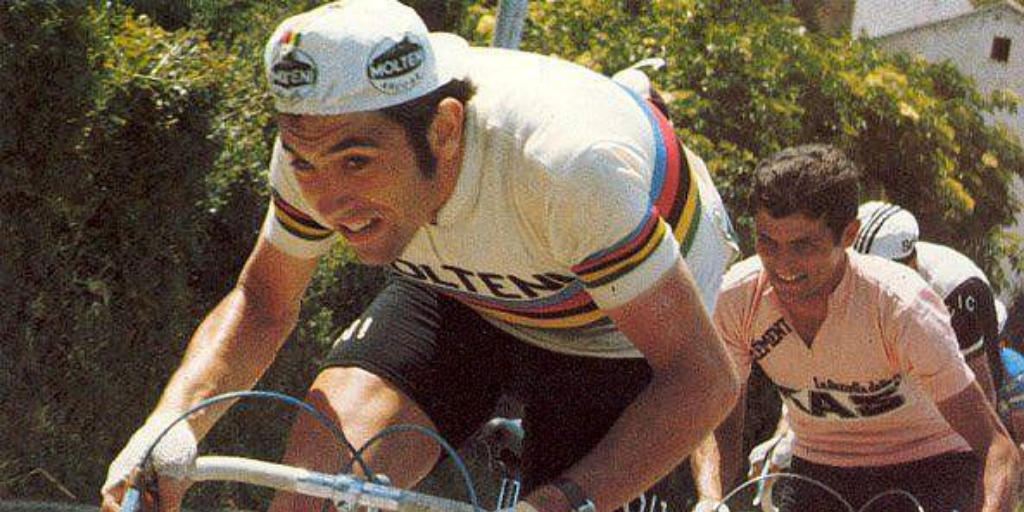Ho to defeat Eddy Merckx (Molteni), that was the question of the 55th Giro d’Italia (21 May- 11 June 1972). Nobody could answer it, although Jose Manuel Fuente (KAS) came quite close to the solution.
The race was 3725 km long, divided into 20 stages. Race director, Vincenzo Torriani wanted a prologue of a time trial in Venice, but the government body of the town refused it in the last minute. Nevertheless, the Giro started in Venice with a 196 km long flat stage to Ravenna won by Marino Basso.
Allegedly, the entire race program was designed by Torriani for José Manuel Fuente, The Spanish rider of the team KAS considered to be one of the pre-race favourites – in the shadow of Eddy Merckx (Molteni), of course. Also, winner of the previous year, Gösta Petterson and his teammate Gianni Motta (both Ferretti) counted to the protagonists, as Felice Gimondi, Italo Zilioli Marino Basso (all Salvarani), Roger de Vlaeminck, Patrick Sercu (both Dreher) and Franco Bitossi (Filotex) either.
The fourth stage (divided into a and b parts) delivered the first spectacle of the race. The first part led up to the top of the Blockhaus, where Eddy Merckx showed his strength for the first time against an elite peloton back in 1967. Now, five years later, this stage gave place to the first attempt to defeat the Cannibal: Fuente reached the top first and gained the pink jersey, which he was able to wear for 3 stages. Nevertheless, Fuente was that fast on that 4/a stage, that several sprinters reached the finish line outside of time limit, and had to leave the race.
Merckx decided to strike back on the seventh stage (including mountains like Monte Scuro and Agnara). He started with an early attack on the 151 km long route. Only Fuente and his teammate Santiago Lazcano was able go with him for a while. On the descent of Monte Scuro Merckx used the advantage of his downhill skills against the two Spaniard, while Gösta Petterson was able to come a bit closer. He managed to finish a race 10 sec behind Merckx. The Belgian supercyclist took the pink jersey that day and managed to hold it until the very end of the race.
Another notable stage was the 14th when the peloton had to climb Monte Jafferau. The ascent was used only 3 times in the history of Giro d’Italia. 1972 was its inaugural year. The stage was 256 km long and included two other ascents. At the bottom of Monte Jafferau, José Manuel Fuente and his teammate Francisco Galdós have a minute advantage ahead of the 9-men chasing group, including Eddy Merckx. Soon Galdios dropped, meanwhile Fuente still was able to keep the one-minute gap four km before the end of the stage. But Merckx launched an attack and managed to reach the finish line 47 sec ahead of Fuente. The Spaniard was even passed by Wladimiro Panizza, who wisely put his wheel behind Merckx’s.
It was a hard day in the saddle on a hard climb. According to Bill and Carol McGann, the authors of the books The Story of the Giro d’Italia: A Year-by-Year History of the Tour of Italy (volume 1 and 2)
Trusting that the Giro management would want to keep the stars in the race, several of the most famous riders blatantly hung onto cars or let themselves get pushed up the Jafferau. Their fame was an insufficient defense and Motta, Bitossi, Zilioli, Willy De Geest and Giovanni Varini were thrown out of the Giro. The day’s cheating was so widespread that most of the others still left in the race were given some form of penalty. The teams threatened to quit if the riders weren’t reinstated, but the race jury stood its ground and the teams stayed in. (source)
Fuente attacked on Stage 16 too, but Merckx was stronger again. The gap between the first and second rider of the General Classification was almost 6 minutes. Next day, on Stage 17 the Spaniard attacked on the Stelvio. This was a hell of a move, even Merckx couldn’t respond it. But Fuente could come closer only with 2 minutes. He gave everything, but Merck was invincible at this Giro d’Italia
Top 10 of the GC
Eddy Merckx (Molteni): 103hr 4min 4sec
José-Manuel Fuente (KAS) 5min 30sec
Francisco Galdós (KAS) 10min 39sec
Vicente López-Carril (KAS) 11min 17sec
Wladimiro Panizza (Zonca) 13min 0sec
Gösta Petterson (Ferretti) 13min 9sec
Roger de Vlaeminck (Dreher) 13min 52sec
Felice Gimondi (Salvarani) 14min 5sec
Miguel-María Lasa (KAS) 14min 19sec
Santiago Lazcano (KAS) 17min 42sec
Follow Peloton&Tales on Instagram for more pics like this from the history of road cycling races
